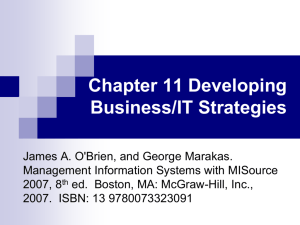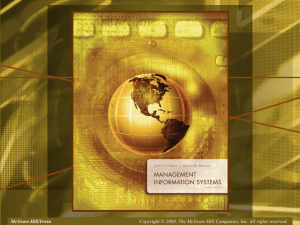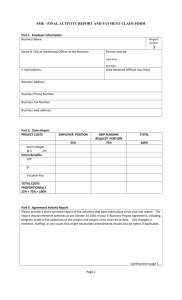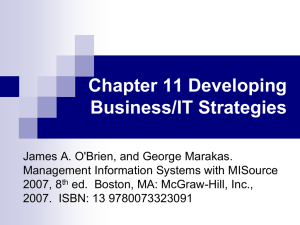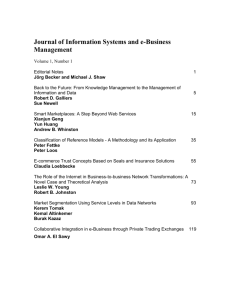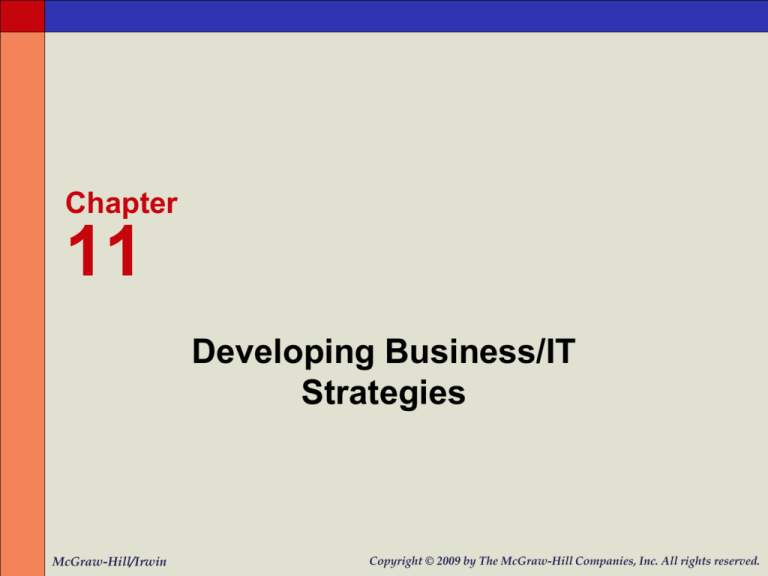
Chapter
11
Developing Business/IT
Strategies
McGraw-Hill/Irwin
Copyright © 2009 by The McGraw-Hill Companies, Inc. All rights reserved.
Learning Objectives
• Discuss the role of planning in the business
use of information technology, using the
scenario approach and planning for
competitive advantage as examples
• Discuss the role of planning and business
models in the development of business/IT
strategies, architectures, and applications
• Identify several change management
solutions for end user resistance to the
implementation of new IT-based business
strategies and applications
11-2
Planning Fundamentals
• Information technology has created a
seismic shift in the way companies do
business
– Just knowing the importance and structure of
e-business is not enough
– You must create and implement an action
plan that allows you to make the transition
from an
old business design to a new e-business
design
11-3
Case 1: Forrester, NMSU, Exante
Financial Services, and Others
• The alignment between business and IT strategy is
crucial to business success; sometimes it is IT that
makes it happen.
• For most CIOs, putting together an IT strategic plan
which helps to improve the business-IT relationship
is very important.
• Businesses may not have a clear strategy or they
may have some strategies, but they may not apply
to all the business activities taking place.
• IT can help the business articulate how IT fits into
business and influence overall business strategy.
11-4
Case Study Questions
1. Consider statements made in the case about business often
not having an overarching business strategy that can serve
as guidance for the development of a strategy for IT. How is
it possible that companies get by without some sort of
stable and clear direction? What does this tell you about the
business and industry environment in which they operate?
2. Dave Aron of Gartner notes that in some cases the lack of
clear business strategy provides an opportunity for IT
leaders to step in and help articulate it and the role IT will
play in the new strategy. This sounds like a good thing for
IT people. What is the downside of being in this situation?
3. Why do you think IT’s success is dependent on the overall
business strategy of an organization? Why must they be
tied together? Provide several reasons.
11-5
Components of Organizational Planning
11-6
Planning
• Strategic Planning
– Deals with the development of an
organization’s mission, goals, strategies, and
policies
– Begins with strategic visioning questions
• Tactical Planning
– The setting of objectives and the
development
of procedures, rules, schedules, and budgets
• Operational Planning
– Done on a short-term basis to implement and
control day-to-day operations
11-7
Strategic Visioning Questions
11-8
The Scenario Approach
• Gaining in popularity as a less
formal, but more realistic, strategic
planning methodology
– Teams of managers and planners
participate in microworld or virtual
world exercises
– Business scenarios are created and
evaluated
– Alternative scenarios are then created
11-9
Trends that Affect Strategic Planning
11-10
Planning for Competitive Advantage
• Strategic business/IT planning
– Involves evaluating the potential benefits
and risks of using IT-based strategies and
technologies for competitive advantage
• The following models can help generate
ideas for the strategic use of IT to
support initiatives
– Competitive forces
– Competitive strategies
– Value chain
11-11
Strategic Opportunities Matrix
11-12
SWOT Analysis
• SWOT stands for
– Strengths: a company’s core competencies
and resources
– Weaknesses: areas of substandard
business performance compared to others
– Opportunities: potential for new business
markets or innovative breakthroughs that
might expand current markets
– Threats: anything that has the potential for
business and market losses
11-13
Business Models and Planning
• Business model answers vital
questions about the fundamental
components of a business
– Who are our customers?
– What do our customers value?
– How much will it cost to deliver that
value?
– How do we make money in this
business?
11-14
Questions for all Business Models
Customer value Are we offering something
distinctive or at a lower cost
than our competitors?
Scope
To which customers is this value
being offered?
What range of products/services
offered embody this value?
Pricing
How do we price the value?
11-15
Questions for all Business Models
Revenue source
Where do the dollars come from?
Who pays for what value and when?
What are the margins in each
market, and what drives them?
What drives value in each source?
Connected
activities
What do we have to do to offer this
value and when?
How connected are these activities?
11-16
Questions for all Business Models
Implementation What structure, systems, people, and
environment do we need to carry out
these activities?
What is the fit between them?
Sustainability
What is it about the firm that makes
it difficult for other to imitate it?
How do we keep making money?
How do we sustain our competitive
advantage?
11-17
Questions for all Business Models
Capabilities
What are our capabilities and
capabilities gaps?
How do we fill these gaps?
Is there something distinctive about
these capabilities that lets us offer
the value better than other firms?
Is this capability hard to imitate?
What are the sources of these
capabilities?
11-18
Questions Specific to E-Business Models
Customer
Value
Scope
What is it about Internet technologies
that allows us to offer customers
something distinctive?
Can Internet technologies help us
to solve a new set of problems for
customers?
What is the scope of customers that
Internet technologies enable us to
reach?
Does the Internet alter the product or
service mix that embodies the firm’s
products?
11-19
Questions Specific to E-Business Models
Pricing
How does the Internet make pricing
different?
Revenue source Are revenue sources different with
the Internet?
What is new?
Connected
activities
How many new activities must be
performed as a result of the Internet?
How much better can Internet
technologies help us perform
existing activities?
11-20
Questions Specific to E-Business Models
Implementation How do Internet technologies affect
the strategy, structure, systems,
people, and environment of the firm?
Capabilities
What new capabilities do we need?
What is the impact of Internet
technologies on existing capabilities?
Sustainability
Do Internet technologies make
sustainability easier or more difficult?
How can the firm take advantage
of it?
11-21
Business Models as Planning Tools
• A business model forces rigorously and
systematic thinking about the value and
viability of business initiatives
– The strategic planning process is then used
to develop unique business strategies that
capitalize on a business model
– The goal is to gain a competitive advantage
in an industry or marketplace
11-22
The Business/IT Planning Process
11-23
The Business/IT Planning Process
• The business/IT planning process
has three major components
– Strategic development
– Resource management
– Technology architecture
11-24
Information Technology Architecture
• The IT architecture is a conceptual
design that includes these major
components
– Technology platform
– Data resources
– Application architecture
– IT organization
11-25
Balanced Scorecard
• The balanced scorecard measures a
company’s activities in terms of vision
and strategies
• The system has four processes
– Translating vision into operational goals
– Communicating the vision and linking it
to individual performance
– Business planning
– Feedback/learning and strategy adjustment
11-26
Balanced Scorecard
• The business perspectives a scorecard
measures
– Financial: reflects financial performance,
such as cash flow or ROI
– Customer: measures having a direct impact on
customers, such as time to process phone calls
– Business process: reflects the performance of key
business processes, such as time spent prospecting
or process costs
– Learning/growth: the company’s learning curve,
such as how many hours are spent training staff
11-27
Identifying Business/IT Strategies
• The most valuable Internet
applications allow companies to
– Transcend communication barriers
– Establish connections that enhance
productivity
– Stimulate innovative development
– Improve customer relations
11-28
Strategic Positioning Matrix
11-29
Strategic Matrix
• Cost and Efficiency Improvements
– Use the Internet as a fast, low-cost way to
communicate and interact with others
– Use of e-mail, chat systems, discussion
groups, and company websites
• Performance Improvement in
Effectiveness
– Major improvements in business
effectiveness
recommended
– Increase use of Internet-based technologies,
such as intranets and extranets
11-30
Strategic Strategies
• Global Market Penetration
– Capitalize on a high degree of customer and
competitor connectivity and use of IT
– Use e-commerce websites with value-added
information services and extensive online
customer support
• Product and Service Transformation
• Develop and deploy new Internet-based
products and services that strategically
reposition it in the marketplace
11-31
E-Business Strategy Examples
• Market Creator: be among the first to
market
and remain ahead of the competition by
continuously innovating
• Channel Reconfiguration: use the
Internet
as a new channel to directly access
customers, make sales, and fulfill orders
• Transaction Intermediary: Use the
Internet
to process purchases
11-32
E-Business Strategy Examples
• Infomediary: use the Internet to reduce the
search cost; offer a unified process for
collecting the information needed to make a
large purchase
• Self-Service Innovator: provide a
comprehensive suite of services that the
customer’s employees can use directly
• Supply Chain Innovator: use the Internet to
streamline supply chain interactions
• Channel Mastery: use the Internet as a sales
and service channel
11-33
Business Application Planning Process
11-34
Comparing Planning Approaches
11-35
E-Business Architecture Planning
11-36
Implementation
• Many companies plan changes very well
– Few manage to convert a plan into action
– This is true even if senior management
consistently identifies e-business as an
area of great opportunity
11-37
Case 2: Blue Cross and Blue Shield and
Others
• Implementing changes needed by new information systems in an
organization is very challenging as employees resist change .
• Understanding the science behind change and resistance to
change can lead to more effective approaches to foster
involvement and smooth out transitions to new systems.
• One of the biggest mistakes managers make is assuming that
everyone is motivated by ambition. Many people are motivated
as much or more by the work they do as they are by the
opportunity to move up in the hierarchy.
• One way to manage change is through education and training.
Employees accept change if they are provided proper education
and training on the new system that is being implemented.
11-38
Case Study Questions
1. Although a very detailed change proposal may prevent people
from making their own connections, as discussed in the case, it
may lead others to consider the proposal to be vague and
unfinished. How do you balance these two concerns? What
guidelines would you use to ensure that you are not veering too
far off in either direction?
2. Kevin Sparks of Blue Cross and Blue Shield of Kansas City had
a difficult time convincing his people of the need for change.
What would you have suggested that he should do before you
read the case? What about afterwards? How did your
recommendations change as a result?
3. Organizational change goes beyond promotions and the threat of
layoffs. What ways other than those discussed in the case would
you use to entice people to embrace proposed changes? Provide
several suggestions and justify their rationale.
11-39
Implementing Information Technology
• Many businesses have undergone multiple
major reorganization since the early 1980s
–
–
–
–
–
–
–
–
Business process reengineering
Installation and upgrades of an ERP system
Upgrading legacy systems to be Y2K compliant
Creating shared service centers
Just-in-time manufacturing
Sales force automation
Contract manufacturing
The introduction of euro currency
• E-business is the latest organizational change
11-40
Impact and Scope of Implementing IT
11-41
Intranet Enterprise Portal Challenges
–
–
–
–
–
–
–
–
–
–
Security, security, security
Defining the scope and purpose of the portal
Finding the time and the money
Ensuring consistent data quality
Getting employees to use it
Organizing the data
Finding technical expertise
Integrating the pieces
Making it easy to use
Providing all users with access
11-42
Enterprise Resource Planning
Challenges
–
–
–
–
–
–
–
–
–
–
Getting end user buy-in
Scheduling/planning
Integrating legacy systems/data
Getting management buy-in
Multiple/international sites and partners
Changing culture and mind-sets
IT training
Getting, keeping IT staff
Moving to a new platform
Performance/system upgrades
11-43
End User Resistance and Involvement
• Any way of doing things generates some
resistance from the people affected
• CRM projects have a history of failure
– Up to 75 percent of CRM projects fail to
meet their objectives
– This is often due to sales force automation
problems and unaddressed cultural issues
– Sales staffs are often resistant to, or fearful
of, using CRM systems
11-44
Keys to Solving End User Resistance
• Keys to solving end user resistance
problems
– Education and training
– End-user involvement in organizational
changes and system development
– Requiring involvement and commitment of
top management and all stakeholders
• Systems that inconvenience or frustrate
users cannot be effective, no matter how
technically elegant or efficient
11-45
Obstacles to KM Systems
11-46
Change Management
People factors have the highest level
of difficulty and the longest time to
resolve of any dimension of
change management
11-47
Key Dimensions of Change Management
11-48
Change Management
• Implementing a new e-business
application may involve
– Developing an action plan
– Assigning managers as change sponsors
– Developing employee change teams
– Encouraging open communications and
feedback about organizational changes
11-49
Change Management
• Key tactics recommended by change experts
– Involve as many people as possible in e-business
planning and application development
– Make constant change an expected part
of the culture
– Tell everyone as much as possible about everything,
as often as possible, in person
– Make liberal use of financial incentives and
recognition
– Work within the company culture, not around it
11-50
A Change Management Process
11-51
Avnet Marshall’s Transformation
11-52
Case 3: 7-Eleven Japan, Eli Lilly, Mohegan
Sun, UPS, Vanguard, Carlson Companies, and
Raytheon
• 7-Eleven blends its IT investments with a
range of assertive IT practices and
capabilities
– Counselor visits to stores twice a week
– Delivers of stock three times a day
– A transparent information infrastructure
that links 70,000 computers at stores,
headquarters, and supplier sites
11-53
Case 3: 7-Eleven Japan, Eli Lilly, Mohegan Sun,
UPS, Vanguard, Carlson Companies, and
Raytheon
• MIT identified four broad classifications
of IT investments that can be managed
as a portfolio to minimize business risk
and optimize return
– Transactional: used to cut costs or
increase throughput for the same cost
– Informational: provide information for
accounting, reporting, compliance,
communication, or analysis
11-54
Case 3: 7-Eleven Japan, Eli Lilly, Mohegan Sun,
UPS, Vanguard, Carlson Companies, and
Raytheon
– Strategic: used to gain competitive
advantage by supporting entry into
new markets or by helping to develop
new products, services, or business
products
– Infrastructure: typically aimed at
providing a flexible base for future
business initiatives or reducing longterm IT costs via consolidation
11-55
Case Study Questions
1. What is the portfolio management approach to IT
planning? Use the four classifications of IT
investments and examples of companies in this
case to illustrate your answer.
2. What are the keys to 7-Eleven Japan’s great
success compared to other retailers in Japan? How
does IT support such success? How could 7-Eleven
Japan do even better? What role would IT play?
Defend your proposal.
3. Compare the IT portfolio investment approaches of
Eli Lilly, Carlson Companies, and Raytheon. What
differences in investment approaches and strategies
do you find? Which approach do you prefer? Why?
11-56
Case 4: Infosys Technologies
•
•
•
•
Infosys has a long history of trying to leverage
knowledge created by its employees for corporate
advantage.
The incentive system they created to encourage
employees to contribute their knowledge created
more problem than the management anticipated.
Eventually Infosys had to change their incentive
system.
Knowledge management requires much more than
technology.
11-57
Case Study Questions
1. Why do you think the knowledge
management system at Infosys faced such
serious implementation challenges? Defend
your answer with examples from the case.
2. What steps did the KM group at Infosys take
to improve participation in the KM system?
Why were some of these initiatives
counterproductive? The KM group
responded with corrective initiatives. Do you
think these will succeed? Why or why not?
11-58
Case Study Questions
3. What change management
initiatives should the KM group have
initiated at Infosys before attempting
to develop and implement
knowledge management at the
company? Defend your proposals,
paying particular attention to the
final quote in the case by a longtime KM manager at Infosys.
11-59

